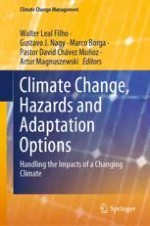2020 | OriginalPaper | Chapter
Climate Change, Extreme Events and Human Mobility in Latin America: Exploring the Links Through National Laws and Policies
Authors : Fernanda de Salles Cavedon-Capdeville, Erika Pires Ramos, Andrea Cristina Godoy Zamur, Diogo Andreola Serraglio, Ignacio Odriozola, Luiza de Moura Pallone, Fernanda Dalla Libera Damacena, Lilian Yamamoto, Giulia Manccini Pinheiro
Published in: Climate Change, Hazards and Adaptation Options
Publisher: Springer International Publishing
Activate our intelligent search to find suitable subject content or patents.
Select sections of text to find matching patents with Artificial Intelligence. powered by
Select sections of text to find additional relevant content using AI-assisted search. powered by
